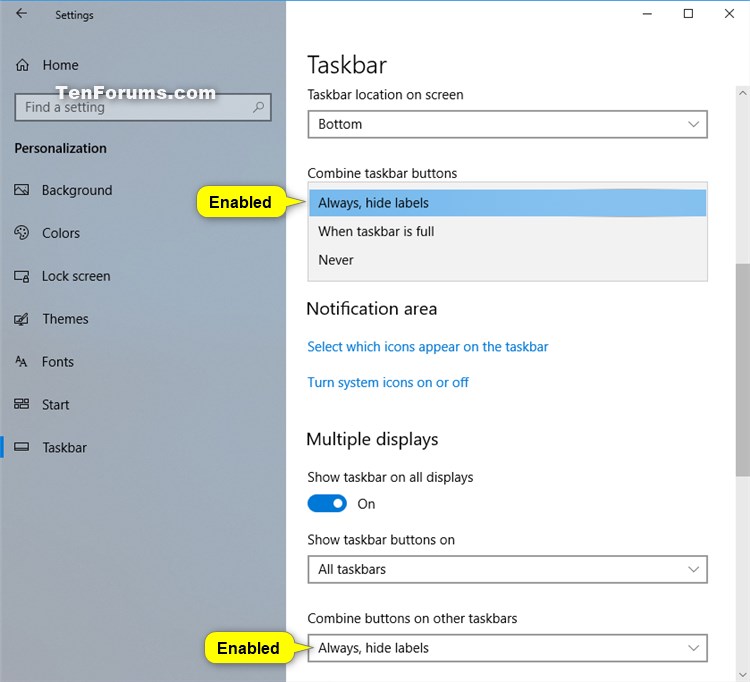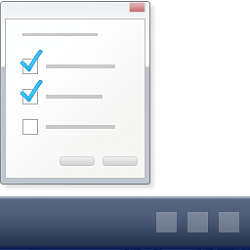How to Enable or Disable Grouping of Taskbar Buttons in Windows
Windows includes a special application desktop toolbar called the taskbar that shows on the bottom of a display screen by default. The taskbar allows you to find, see, open, and switch between your apps. You can also see the date and time, system icons, and items running in the background on the notification area. You can make the taskbar look how you want, manage your calendar, pin your favorite apps to it, change the size, change location on screen, and specify how taskbar buttons group together when you have more than one window open.
If you have multiple displays, then you will be able to set button grouping separately for the main taskbar and other taskbars.
Taskbar Button Grouping Options:
- Always combine, hide labels - This is the default setting. Each app appears as a single, unlabeled button (icon), even when multiple windows for an app are open.
- Combine when taskbar is full - This setting shows each open window as an individual, labeled button. When the taskbar becomes crowded, apps with multiple open windows collapse into a single app button. Clicking the button displays a list of the windows that are open.
- Never combine - This setting shows each window as an individual, labeled button, and never combines them, no matter how many windows are open. As more apps and windows open, buttons get smaller, and eventually the buttons will scroll.
If you like, you can prevent the grouping of taskbar buttons in Windows.
If disabled, taskbar buttons will be set to always never combine, and the Combine taskbar buttons and Combine button on other taskbars settings will be grayed out.
This tutorial will show you how to enable or disable grouping of taskbar buttons for specific or all users in Windows 7, Windows 8, and Windows 10.
You must be signed in as an administrator to enable or disable taskbar grouping.
Contents
- Option One: Enable or Disable Grouping of Taskbar Buttons in Local Group Policy Editor
- Option Two: Enable or Disable Grouping of Taskbar Buttons for All Users using a REG file
EXAMPLE: Grouping of Taskbar Buttons enabled and disabled

In Windows 7, the Local Group Policy Editor is only available in the Professional, Ultimate, and Enterprise editions.
In Windows 8, the Local Group Policy Editor is only available in the Pro and Enterprise editions.
In Windows 10, the Local Group Policy Editor is only available in the Pro, Enterprise, and Education editions.
All editions can use Option Two.
1 Open the all users, specific users or groups, or all users except administrators Local Group Policy Editor for how you want this policy applied.
2 In the left pane of the Local Group Policy Editor, click/tap on to expand User Configuration, Administrative Templates, and Start Menu and Taskbar. (see screenshot below)
3 In the right pane of Start Menu and Taskbar, double click/tap on the Prevent grouping of taskbar items policy to edit it. (see screenshot above)
4 Do step 5 (enable) or step 6 (disable) below for what you would like to do.
A) Select (dot) either Not Configured or Disabled, click/tap on OK, and go to step 7 below. (see screenshot below)
Not Configured is the default setting.
7 When finished, you can close Local Group Policy Editor if you like.
The downloadable .reg files below will add and modify the DWORD value in the registry keys below.
HKEY_CURRENT_USER\Software\Microsoft\Windows\CurrentVersion\Policies\Explorer
HKEY_LOCAL_MACHINE\SOFTWARE\Microsoft\Windows\CurrentVersion\Policies\Explorer
NoTaskGrouping DWORD
(delete) = Enable
1 = Disable
1 Do step 2 (enable) or step 3 (disable) below for what you would like to do.
This is the default setting.
A) Click/tap on the Download button below to download the file below, and go to step 4 below.
Enable_grouping_of_taskbar_buttons.reg
Download
A) Click/tap on the Download button below to download the file below, and go to step 4 below.
Disable_grouping_of_taskbar_buttons.reg
Download
4 Save the .reg file to your desktop.
5 Double click/tap on the downloaded .reg file to merge it.
6 When prompted, click/tap on Run, Yes (UAC), Yes, and OK to approve the merge.
7 You can either restart the explorer process, sign out and sign in, or restart the computer to apply.
8 You could now delete the downloaded .reg file if you like.
That's it,
Shawn
Related Tutorials
- How to Always, Sometimes, or Never Combine Taskbar Buttons in Windows 10
- How to Use Large or Small Taskbar Buttons in Windows 10
- How to Change Width of Taskbar Buttons in Windows
- How to Hide or Show Badges on Taskbar Buttons in Windows 10
- How to Change How Many Times Taskbar Button Flashes in Windows 10
- How to Enable or Disable Taskbar Settings in Windows 10
Enable or Disable Grouping of Taskbar Buttons in Windows
-
New #1
do not group or combine
I want to stop the taskbar buttons or icons from grouping when not combined. taskbar buttons or icons currently always group even when not combined.
That is, all Excel buttons for open windows will be grouped next to each other. Same for all buttons of any specific application I want to keep them from grouping & allow them to be moved independently ...as is allowed with 7+ Taskbar Tweaker.
However 7+ Taskbar Tweaker is flagged as malware by Cylance Protect and no longer usable on my corporate computer.
-
New #2
Hello Kurt, and welcome to Ten Forums.
You should be able to use step 3 in Option Two to disable grouping of taskbar buttons for all users.
If you just wanted to affect your account, you can set "Combine taskbar buttons" to "Never" below.
Always, Sometimes, or Never Combine Taskbar Buttons in Windows 10
Just to note, that buttons for the same app will only appear separately per opened window, and not per opened tab. For example, Google Chrome.
-
New #3
I used option 3 to disable the combining of taskbar buttons but it does not stop the grouping of taskbar buttons.
The buttons of the same applications are still connected and cannot be separated.
For example all Excel buttons (for open worksheets) are still grouped together. Not combined into a single button, but the buttons of like applications are grouped or connected and cannot be separated.
-
-
New #5
I open the Excel docs separately by clicking on the existing workbook file.
Is there another way to open Excel files in separate windows?
-
New #6
I just tested with Excel, and if you have "Combine taskbar buttons" set to "Never" in Taskbar settings, each opened Excel window will have its own taskbar button.
This is how I opened a separate Excel window:
1) Right click on the Excel taskbar button to open its jump list
2) Press and hold the Shift key, and click on Excel in the jump list.
3) Release the Shift key.
-
New #7
Thank you for the assistance.
I followed your instructions but still all Excel Buttons that open, are grouped together.
By grouped together I mean they are all separate buttons but the buttons are physically connected to each other, side by side. When I move any one of them, they all move together as a group, rather than individually.
-
-
-
New #9
You can enable moving buttons/apps within groups by using the latest version of 7+ Taskbar Tweaker . Once you've enabled it you need to use the right mouse button to drag them, not the left. Just tried it and it works fine on windows 10 (version 1809).
If anyone knows which registry setting or file this changes it would be great to know.

Enable or Disable Grouping of Taskbar Buttons in Windows
How to Enable or Disable Grouping of Taskbar Buttons in WindowsPublished by Shawn BrinkCategory: Customization
27 Nov 2019
Tutorial Categories


Related Discussions








 Quote
Quote
